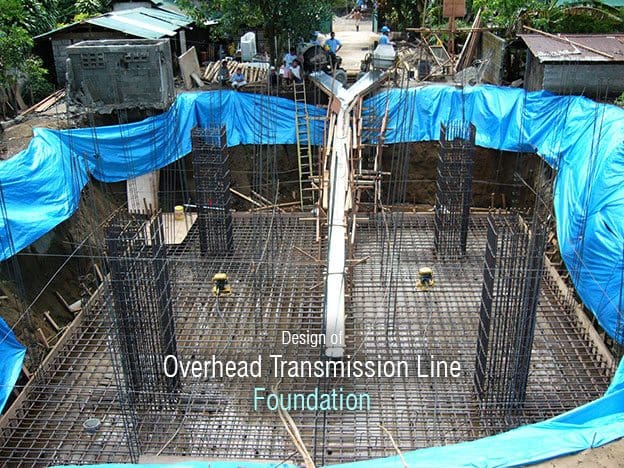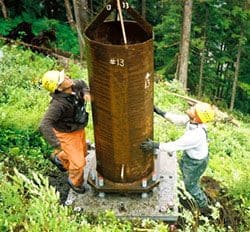 |
| Design of Overhead Transmission Line Foundation |
General
The foundation is the name given to the system which transfers to the ground the various steady state (dead) and variable (live) loads developed by the transmission tower and conductors. Foundations may be variously subjected to compressive or bearing forces, uplift and shear forces, either singly or as a result of any combination of two or three of the forces.
Usually, the limiting design load with transmission line foundations is the uplift load.

In this respect, there is a major difference between the design of foundations for transmission lines compared to the design of foundations for most normal civil engineering structures.
Accordingly, the amount of literature describing design techniques for overhead line foundations is relatively small compared to the literature available for more traditional civil engineering foundation design practice.
The selected foundation design for a particular tower must provide an economical, reliable support for the life of the line. The foundation must be compatible with the soil and must not lose strength with age.
With the progressive increase in transmission system voltages there has been a related increase in foundation sizes and it is worth noting that with a typical quad conductor 500 kV line, single leg uplift and ultimate compression loads of 70 or 80 tonnes are usual for suspension towers.
With tension towers, ultimate loads of 200 or 300 tonnes are often developed.
In ground of poor load-bearing capacity the dimensions of foundations become considerable.
In the past, it was often acceptable to ‘over-design’ foundations to allow for uncertainties in the soil characteristics. With the large sizes of foundations for EHV and UHV transmission it is obvious that significant economies can be made in producing foundation designs to exactly match the soil conditions.
Increasingly, transmission lines are routed through areas of poor ground conditions, often for reasons of amenity. This results in the need for the use of special, generally larger, foundations.
The logistical problems of installing large foundations, often in difficult ground conditions, must be taken into account when considering foundation design.
Types of ground

The ground in which the foundations are installed can vary from igneous, sedimentary or metamorphic rock, noncohesive soils, sand or gravel to cohesive soil, usually clays. Equally, soils with a high organic content, for example peat, can also prevail. Composite soils will also be found, and examples of these are sandy gravels and silty sand or sandy peat.
Fundamental to the proper design of foundations is an accurate series of soil tests to determine the range of soil types for which the foundation designs will be required. It is good practice to carry out soil tests at a rate of 1 in 5 tower sites.
This is generally sufficient to enable an accurate forecast of the range of soil types to be established.
It should be pointed out, however, that with large towers having 15 or 20 m square bases, occasionally each of the four legs of a tower may be founded in four different types of ground.
Types of foundation
There are seven basic types of tower foundations:
- Steel grillage
- Concrete spread footing
- Concrete auger or caisson
- Pile foundation
- Rock foundation
- Raft foundation
- Novel foundations.
Foundation calculations
There are a number of methods of calculation of foundation uplift and bearing capacity. For the purposes of this article, however, we will confine ourselves to a simple approach which must be treated with care. Nevertheless, the methods indicated will give reasonably accurate results for the relatively shallow foundations which are normally employed with transmission line towers.
A shallow foundation is usually defined as one in which the breadth of the pad is greater than the setting depth.
It is usual to calculate the uplift capacity of a foundation as being equal to the mass of soil contained in the frustum developed between the base of the foundation pad and the soil surface.
The angle of the face of the frustum to the vertical is usually designated @ and will vary from35° to 40° in rock, to 25° in good homogeneous hard clay to zero in saturated noncohesive ground. The soil density will vary from just over 2000 kg/m3 for homogeneous rock to about 1600 kg/m3 for soil with normal moisture content to about 800 or 900 kg/m3 in the case of ground subjected to water uplift.
Methods of calculation of uplift capacity are shown below.
Undercut Pyramid Foundation

Undercut pyramid foundation calculation
Concrete Auger Foundation

Concrete auger foundation calculation
Resource: High voltage engineering and testing – Hugh M. Ryan (Buy this book at Amazon)
No comments:
Post a Comment